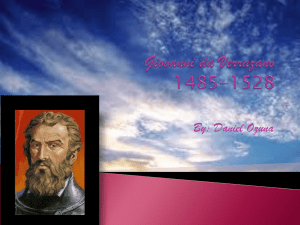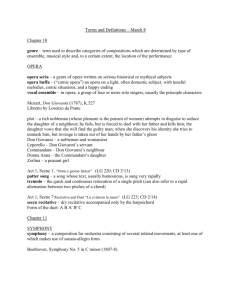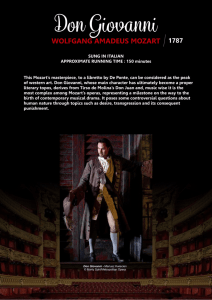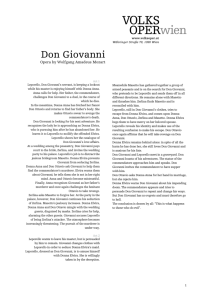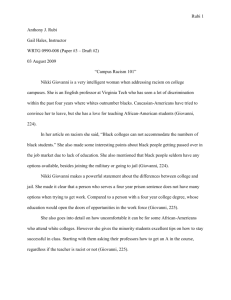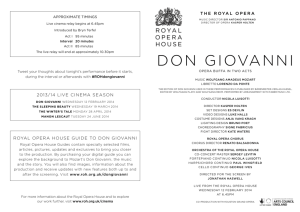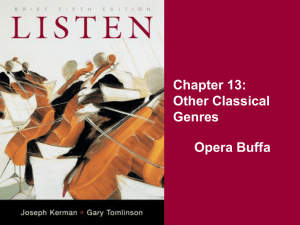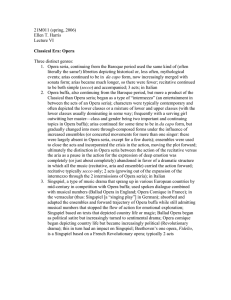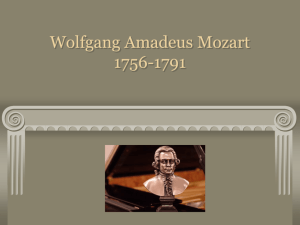Don Giovanni analysis
advertisement
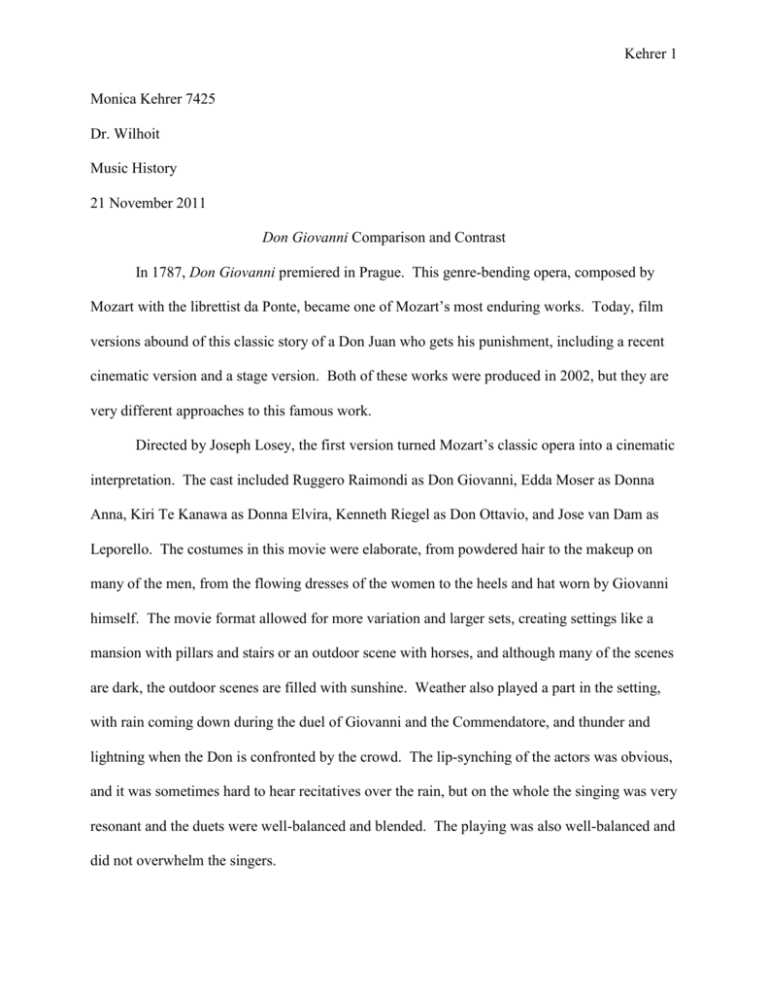
Kehrer 1 Monica Kehrer 7425 Dr. Wilhoit Music History 21 November 2011 Don Giovanni Comparison and Contrast In 1787, Don Giovanni premiered in Prague. This genre-bending opera, composed by Mozart with the librettist da Ponte, became one of Mozart’s most enduring works. Today, film versions abound of this classic story of a Don Juan who gets his punishment, including a recent cinematic version and a stage version. Both of these works were produced in 2002, but they are very different approaches to this famous work. Directed by Joseph Losey, the first version turned Mozart’s classic opera into a cinematic interpretation. The cast included Ruggero Raimondi as Don Giovanni, Edda Moser as Donna Anna, Kiri Te Kanawa as Donna Elvira, Kenneth Riegel as Don Ottavio, and Jose van Dam as Leporello. The costumes in this movie were elaborate, from powdered hair to the makeup on many of the men, from the flowing dresses of the women to the heels and hat worn by Giovanni himself. The movie format allowed for more variation and larger sets, creating settings like a mansion with pillars and stairs or an outdoor scene with horses, and although many of the scenes are dark, the outdoor scenes are filled with sunshine. Weather also played a part in the setting, with rain coming down during the duel of Giovanni and the Commendatore, and thunder and lightning when the Don is confronted by the crowd. The lip-synching of the actors was obvious, and it was sometimes hard to hear recitatives over the rain, but on the whole the singing was very resonant and the duets were well-balanced and blended. The playing was also well-balanced and did not overwhelm the singers. Kehrer 2 The humor of Don Giovanni was presented very well in this movie. The gate that Don Giovanni slams in Donna Anna’s face during the first scene of the movie is echoed by a similar gate closing on Donna Elvira. Likewise, Giovanni’s and Leporello’s unconvincing masks echo those of Ottavio, Elvira, and Anna at the Don’s party earlier in the opera. The movie also interpreted some aspects of the opera in interesting ways. For example, in the opening of the second act, Giovanni and Leporello rest their heads on a sleeping, naked woman as they sing, apparently one of the Don’s conquests from the night before. In contrast with traditional approaches, which present the overture as preceding the action, the Mozart-Losey version played it as underscoring as Don Giovanni arrived in the city. The glassblowers were also shown at work, which connected to the end of the movie as Giovanni was pulled into the glassblowers’ bowl of flames. Overall, the medium enabled a focus on one or two people at a time and made it much easier to see expressions of the actors, although on occasion the close-ups seemed unnatural. The staged version was directed by Jurgen Flimm, and the cast included Rodney Gilfry as Don Giovanni, Laszlo Polgar as Leporello, Cecilia Bartoli as Donna Elvira, Isabel Rey as Donna Anna, and Liliana Nikiteanu as Zerlina. Nicholas Harnoncourt conducted the Zurich Opera. The costumes and scenery were much simpler in this version, mostly because it was a stage version of the opera. The performers were dressed in more modern clothes, such as button-down shirts and jackets. The lighting was very dark most of the time, and the stage itself rotated to present more scenery. The singing and playing were both excellent, with strong and talented performers and a good balance between the singers and the orchestra. The characters themselves were presented differently from those in the Mozart-Losey version. Giovanni was younger and seemed more suave and likeable, while Zerlina seemed to be more of a willing participant in the Kehrer 3 Don’s escapades. Laszlo Polgar did a wonderful job portraying Leporello, with his gestures, facial expressions, and voice changes. Because of the lack of scenery, the performers did more with motions and facial expression. However, the acting was less melodramatic than the Mozart-Losey version. There was also a good deal of humor in this version, such as the scene in which the Don puts his arms through Leporello’s to make motions when singing to Elvira outside her window. Giovanni also carries around and pretends to feed a statue, making fun of the statue of the Commendatore. The camera work seemed shaky at times, cutting abruptly between actors to focus on everyone singing, and extraneous sounds such as footsteps could be distracting, but on the whole the production was true to the original opera. However, the ending was an exception—as the performers sing the final aria, Questo è il fin, the Don appears in the background kissing a woman, and a car is shown in the scenery. This scene is never explained. Overall, both productions of Don Giovanni starred some talented performers and showcased the humor and drama of the opera. Each version had its own take on the characters, and the performers in the Mozart-Flimm version seemed stronger than those in the Mozart-Losey version. However, the cinematic version was visually beautiful and took full advantage of the space afforded by not performing on a stage. The costumes were flamboyant, and the ending was fitting for the opera. Still, both versions delivered an entertaining, thoughtful look at Don Giovanni, and seeing the variations in both productions provides a deeper look into the classic opera. WORD COUNT: 875 words
